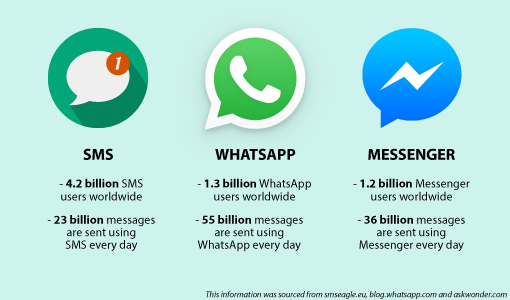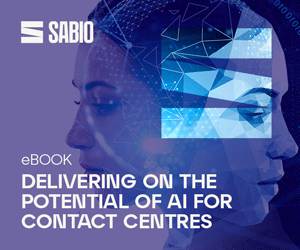Our panel of experts share their thoughts on whether or not messaging apps will soon be a contact centre mainstay.
Messaging Is Becoming a Key Customer Engagement Strategy
As consumers, we know that when we reach for our smartphones it’s to check messages, social media updates or emails.
It has become an almost instinctive impulse, and – consequently – one that means that effective messaging needs to sit at the heart of any successful customer engagement strategy.
And, to engage with your customers, it makes sense to be where your customers are.
With Facebook’s combined WhatsApp and Messenger throughput alone now processing three times as many messages as traditional daily SMS volumes, it’s clear that messaging has an important role to play in the end-to-end customer journey.

However, the contact centre must remember that the quality of the integration with other digital and assisted channels will prove critical.
What About Other Messaging Platforms?
While it’s easy to think of just Facebook and Microsoft, when it comes to setting the agenda for messaging innovation, it’s actually the Chinese WeChat service that has set the pattern for more comprehensive messaging platforms.
With its range of integrated services, it’s easy to see why so many Chinese users find platforms such as WeChat fit so easily into their daily lives.
If they’re already busy on WeChat, why go elsewhere to another platform to engage and transact with the many different organisations or services they use?
How Messaging Apps Are Integrated with Other Channels Needs Some Thinking
Messaging needs to be part of a carefully crafted customer journey, so it’s essential that messaging users have clear escalation paths.
For example, they might begin their engagement via a Virtual Assistant or a Messenger-style thread, then drop into webchat for a more involved discussion, finally opting for a live conversation if more complex issues are being discussed.

Dan Whaley
At each handover point, the transition should be seamless, as customers will grow frustrated if their ongoing engagement isn’t informed by their interactions across other channels such as voice, email or SMS.
Also, contact centres will have to think about how these apps will impact on existing customer journeys and recognise that these platforms have the capacity to bypass, or even undermine, an organisation’s existing Digital Front Door strategy.
All approaches have a valuable role to play: the key is to create a structured messaging environment that remains focused on customer needs and effort rather than internal processes.
Thanks to Dan Whaley at Sabio
It Will Be a Mainstream Channel, but Only for Simple Enquiries
It is difficult to predict what the next mainstream channel will be in contact centres. However, one thing is certain, omnichannel is here to stay, as different channels work best for different types of customer interactions.
For example, complex or personal enquiries are best suited to voice or email, whereas messaging apps are best for simple enquiries.
It is important to allow customers to switch between channels depending on the type of query they have and which device they are using at the time.
For those people who like Messenger and WhatsApp, these are perfect for customer service because they are quick and typically provide an immediate response. However, the same is true of voice for those who prefer a more traditional channel.
The secret to solving customer interactions is the ability to respond quickly and efficiently, whatever the channel.
The Take-Up May Be Slower Than Expected
For years there have been predictions that telephone customer service would be a thing of the past. However, it remains the go-to channel for many age groups and industries.
Back in 2013, Gartner, in its report “What you need to know about social media for customer service”, said that by 2015, businesses that lack an all-channel customer engagement strategy would lose 15% to 20% of their best customers to competitors that have such a strategy.

Christian Thorsrud
Has that really happened?
Apparently not, as a survey conducted by Call Centre Helper towards the end of 2015 showed that 55.7% of customer interactions still occurred by voice, an increase on the previous year.
Having said that, it would be foolish to ignore the popularity of mobile devices and new communication channels. And, while Messenger and WhatsApp currently lead the way, by next year there could be yet more new mobile apps appearing.
Thanks to Christian Thorsrud at Puzzel
Messaging Apps Are the Preferred Channel for Millennials
As the preferred communication channel for millennials, with 41% claiming they would be ‘truly satisfied’ if they could use messaging apps to connect with businesses (The Center for Generational Kinetics), adoption of messaging apps continues to grow rapidly.
In fact, there have been a number of recent examples of messaging apps coming to the forefront of many organisations’ customer service strategy.
For example:
- Uber launched a feature allowing its customers to hail a ride through Facebook Messenger
- KLM now allows passengers to manage all aspects of their flight via a messenger plug-in
- Burger King even offered the capability for hungry customers to order ahead using a feature integrated into Facebook’s Messenger app

Ashley Unitt
With these organisations doing so, Gartner Research predicts that by 2019, requests for customer support through consumer mobile messaging apps will exceed requests for customer support through traditional social media.
Yet, while some may remain sceptical about such figures, remember that where people migrate, businesses tend to follow, and messaging apps are currently taking over the internet.
After all, it was just last year that Techco reported that the number of active users across WhatsApp, Facebook Messenger and WeChat had outgrown both Instagram and Twitter.
Thanks to Ashley Unitt at NewVoiceMedia
Customer Service Is a Step Behind Private Communication
Today most communication still happens via email and phone, with companies using live chat for website support as well.
In this respect, customer service has been a step behind private communication, which increasingly takes place via messengers and social networks.
The way people communicate is changing at a staggering pace, becoming easier, faster, and more frequent. Customer service needs to adjust to these new forms of communication.
In fact, there is a lot of evidence to suggest that, over time, messaging apps will likely become the dominant mode of communication, because messaging offers benefits to both customers and businesses.

Colin Campbell
It’s instant. You see when the other side is present and you can have a live conversation. It’s also non-instant, since you can answer whenever you read a message.
Knowing that a question has been read relieves pressure on both sides, as customers know the answer will reach them anywhere, right on their phone. That’s a big advantage to the phone and email process.
Thanks to Colin Campbell at Olive
Messaging Apps Like WhatsApp Have Many Advantages Over More Traditional Channels
With 1.2 billion users, WhatsApp has become the king of messaging. It is a platform that many of your customers will regularly use and trust.
Also, with WhatsApp, conversations are personal and private, with end-to-end encryption. That means that customer complaints won’t be visible to the outside world, making it a better stage for both the advisor and the customer.
What also helps is that users are always on and alert to notifications. This means customers are more likely to see messages and become engaged with them, as well as with WhatsApp’s own broadcast lists.

Chris Streete
Consequently, it is easier for marketers to contact friends of customers with shared interests, provided they have opted in and it is both relevant and engaging.
WhatsApp also offers a compelling platform for automated self-service, particularly chatbots. However, the opportunity to use WhatsApp for customer service may not be immediately available to companies.
But now is the time to think about the impact mobile apps like this have on the customer experience.
Thanks to Chris Streete at Aspect
Many Customers Would Like to Use a Messaging App as a Starting Point for Their Journey
In my view, everyone is becoming so time poor that they don’t really want to be forced to switch between platforms to carry out different communication tasks. They want companies to make communicating with them as easy as possible.
So, if you’re a Messenger user, you’ll want to use Messenger to communicate with a brand.

Frank Sherlock
Does that mean consumers will only use one channel to cover the entire customer journey? I believe the answer is a resounding no!
Customers may start the journey with a WhatsApp message but they will probably want to speak to a human being at some point and may use a chat to get advice or provide personal details.
Thanks to Frank Sherlock at CallMiner
Companies Should Start Looking Beyond Traditional Contact Methods
With technology fast evolving, it is important for companies to look beyond traditional ways of interacting with the customer and expand to new offerings that meet customers’ expectations.
Many of these customers will be using mobile messengers such as Facebook Messenger, WhatsApp and WeChat, which have become the chosen means of communication on mobile devices.
As an example, WhatsApp has reached more than a billion monthly active users, while Facebook Messenger is not far behind with 900 million, and WeChat with almost 700 million.

David Paulding
Taking this into consideration, the benefits for the contact centre are numerous.
For example, with WhatsApp chat, several customer issues could be handled at the same time, enabling companies to reduce costs per customer contact while maintaining high-quality one-on-one advice with a professional and efficient service.
Another benefit is allowing advisors to hold an active dialogue with several customers on a particular topic.
Thanks to David Paulding at Genesys
The Short Answer Is Yes – and Contact Centres Will Need to Adapt
There has been a marked increase in the volume of contacts coming via these new channels, where the convenience, the low cost and the generational shift is proving an unstoppable force.
This means that contact centres need to have the ability to keep up with the pace of change and proactively adapt.

Darren Deehan
Yet this may be a challenge, as all too often we see that contact centres do not forecast webchat or email at all. Instead, they simply set a requirement that X number of advisors will manage those queues or they simply pick them up when call volumes drop.
If customers are going to be using these channels then they will expect a level of service that matches or indeed exceeds what they have been used to.
At this moment in time, voice remains the default way of solving complex questions and expressing emotion beyond a three-character smiley face.
Thanks to Darren Deehan at Injixo
Do you think that messaging apps will become the next mainstream channel in the contact centre?
Please leave your thoughts in an email to Call Centre Helper.
Author: Robyn Coppell
Published On: 4th Sep 2017 - Last modified: 15th Aug 2025
Read more about - Customer Service Strategy, Alvaria, CallMiner, Genesys, Olive, Omnichannel, Peopleware, Puzzel, Sabio, Service Strategy, Vonage








































Hello Team,
I really appreciate the insight presented here on the alternatives to assisting customers rather than the more common approach of voice and email and would very much want to exploit it.
But the limitation I see is the inability to respond to concurrent customer’s like you can via voice and SMS, since customers reach you via single channel knowing that these medium have single session limits as well.Additionally reporting of such interactions would also not be easy unlike voice , ordinarily looking at it a huge percentage of customers are available via this medium and would appreciate prompt reverts on queries shared without facing rigors of call queues.
Presently thinking up on how to present this to a client with hope of setting it up as an addition to existing mode of customer contact with an obvious option of migration to voice channel’s depending on peculiarities of customer’s complaints. Would thus appreciate any ideas or support in that direction.
Thanks